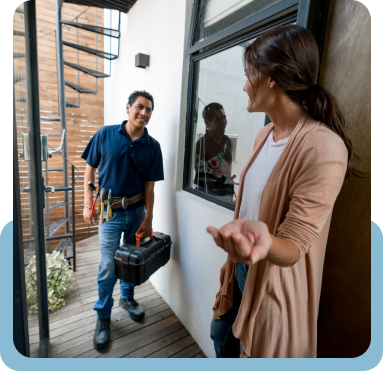Home and business owners concerned about air quality should consider air scrubbers in Garland, TX. There are many potential pollutants in your indoor air. Those pollutants can also be more concentrated due to the lower ventilation and circulation inside. Affordable Air will personalize your air scrubber installation to your location. Your air scrubber will give you peace of mind by actively cleaning your air of particulates, gases, chemicals, and more.
Air Scrubbers in Garland, TX
FREE Estimate
Air Scrubbers for Cleaner Air
There are different types of air scrubbers available, including portable and integrated systems. The latter type integrates into the HVAC system. We’ll generally install it on the return side where it won’t hurt static pressure. There are dry scrubbers that pull air through a series of filters. Available as both integrated and portable systems, they’re the most common for homes and businesses. Wet scrubbers use water vapor to trap pollutants and are most common in manufacturing facilities.
An important concept in air scrubbing is air changes per hour (ACH). It factors the blower cubic feet per minute and airflow resistance of the filters within the context of the treatment volume. The treatment volume is often the square or cubic footage of the home. The recommended minimum for an air scrubber is four ACH. Many systems for the home provide at least five. Six or more may be preferable if someone in the home has asthma or severe allergies.
A typical air scrubber installation will have several air filtration stages. There’s often a prefilter to trap the largest particles and preserve the other filter media. Many systems use a high-efficiency particulate air (HEPA) filter for the primary mechanical filtration. A HEPA filter traps over 99% of the particles that pass through the system.
Many systems have activated carbon as a filter. Activated carbon is an adsorptive material that neutralizes gases and chemicals. In doing so, it provides excellent odor control. Some systems also have a molecular filter to neutralize germs, mold, and viruses.
- Fewer headaches and body aches
- More energy and higher cognitive function
- Allergy relief and asthma management
- Less respiratory irritation and inflammation
- Reduced risk of infections and other illnesses

Air Scrubber Installation in Garland
Affordable Air is an HVAC contractor serving Garland. We serve both residential and commercial customers. Our company offers a wide range of air scrubbing technologies, and our technicians install all brands and models. We often have specials available, provide free estimates for installations, and offer flexible financing options on approved credit.
An on-site consultation is a great way to learn more about air scrubbers in Garland. Call Affordable Air today or contact us online to schedule yours.